堆栈和队列基本函数
数据结构-栈与队列

栈 1.6栈的应用
运算符的优先级关系表在运算过程中非常重要,它是判定进栈、出栈的重要依据。
θ1
θ2
+
-
+
>
>
-
>
>
*
>
>
/
>
>
(
<
<
)
>
>
#
<
<
*
/
(
)
#
<
<
<
>
>
<
<
<
>
>
>
>
<
>
>
>
>
<
>
>
<
<
<
=
>
>
>
>
<
<
<
=
栈
1.6栈的应用
下面以分析表达式 4+2*3-12/(7-5)为例来说明求解过程,从而总结出表达式求值的算 法。求解中设置两个栈:操作数栈和运算符栈。从左至右扫描表达式:# 4+2*3-12/(7-5) #, 最左边是开始符,最右边是结束符。表达式求值的过程如下表所示:
1.4栈的顺序存储结构
设计进栈算法——Push 函数。首先,判断栈是否已满,如果栈已满,就运用 realloc 函 数重新开辟更大的栈空间。如果 realloc 函数返回值为空,提示溢出,则更新栈的地址以及栈 的当前空间大小。最终,新元素入栈,栈顶标识 top 加 1。
数据结构--栈和队列基础知识

数据结构--栈和队列基础知识⼀概述栈和队列,严格意义上来说,也属于线性表,因为它们也都⽤于存储逻辑关系为 "⼀对⼀" 的数据,但由于它们⽐较特殊,因此将其单独作为⼀篇⽂章,做重点讲解。
既然栈和队列都属于线性表,根据线性表分为顺序表和链表的特点,栈也可分为顺序栈和链表,队列也分为顺序队列和链队列,这些内容都会在本章做详细讲解。
使⽤栈结构存储数据,讲究“先进后出”,即最先进栈的数据,最后出栈;使⽤队列存储数据,讲究 "先进先出",即最先进队列的数据,也最先出队列。
⼆栈2.1 栈的基本概念同顺序表和链表⼀样,栈也是⽤来存储逻辑关系为 "⼀对⼀" 数据的线性存储结构,如下图所⽰。
从上图我们看到,栈存储结构与之前所了解的线性存储结构有所差异,这缘于栈对数据 "存" 和 "取" 的过程有特殊的要求:1. 栈只能从表的⼀端存取数据,另⼀端是封闭的;2. 在栈中,⽆论是存数据还是取数据,都必须遵循"先进后出"的原则,即最先进栈的元素最后出栈。
拿图 1 的栈来说,从图中数据的存储状态可判断出,元素 1 是最先进的栈。
因此,当需要从栈中取出元素 1 时,根据"先进后出"的原则,需提前将元素 3 和元素 2 从栈中取出,然后才能成功取出元素 1。
因此,我们可以给栈下⼀个定义,即栈是⼀种只能从表的⼀端存取数据且遵循 "先进后出" 原则的线性存储结构。
通常,栈的开⼝端被称为栈顶;相应地,封⼝端被称为栈底。
因此,栈顶元素指的就是距离栈顶最近的元素,拿下图中的栈顶元素为元素 4;同理,栈底元素指的是位于栈最底部的元素,下中的栈底元素为元素 1。
2.2 进栈和出栈基于栈结构的特点,在实际应⽤中,通常只会对栈执⾏以下两种操作:向栈中添加元素,此过程被称为"进栈"(⼊栈或压栈);从栈中提取出指定元素,此过程被称为"出栈"(或弹栈);2.3 栈的具体实现栈是⼀种 "特殊" 的线性存储结构,因此栈的具体实现有以下两种⽅式:1. 顺序栈:采⽤顺序存储结构可以模拟栈存储数据的特点,从⽽实现栈存储结构。
第三章 栈和队列
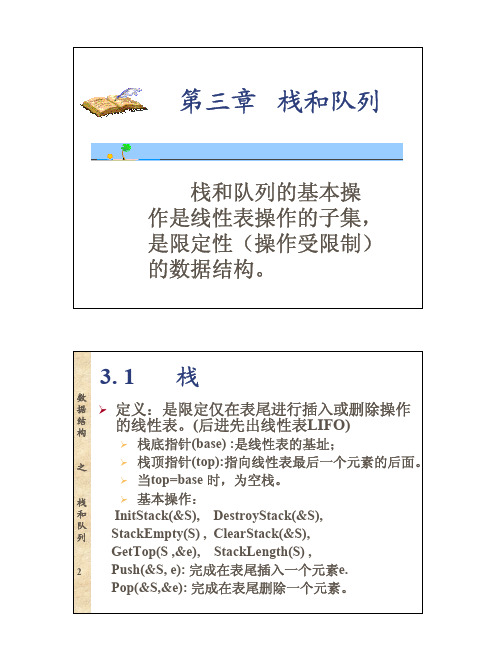
栈和队列的基本操作是线性表操作的子集,是限定性(操作受限制)的数据结构。
第三章栈和队列数据结构之栈和队列23. 1 栈¾定义:是限定仅在表尾进行插入或删除操作的线性表。
(后进先出线性表LIFO)¾栈底指针(base) :是线性表的基址;¾栈顶指针(top):指向线性表最后一个元素的后面。
¾当top=base 时,为空栈。
¾基本操作:InitStack(&S), DestroyStack(&S),StackEmpty(S) , ClearStack(&S),GetTop(S ,&e), StackLength(S) ,Push(&S, e): 完成在表尾插入一个元素e.Pop(&S,&e): 完成在表尾删除一个元素。
数据结构之栈和队列3¾栈的表示和实现¾顺序栈:是利用一组地址连续的存储单元依次存放自栈底到栈顶的数据元素;栈满之后,可再追加栈空间即为动态栈。
¾顺序栈的结构类型定义:typedef int SElemType;typedef struct{SElemType *base; /* 栈底指针*/SElemType *top; /* 栈顶指针*/int stacksize; /* 栈空间大小*/ }SqStack;数据结构之栈和队列4¾基本算法描述¾建立能存放50个栈元素的空栈#define STACK_INIT_SIZE 50#define STACKINCREMENT 10Status InitStack_Sq(Stack &S){S.base=(SET*)malloc(STACK_INIT_SIZE *sizeof(SET)); /*为栈分配空间*/if(S.base==NULL)exit(OVERFLOW); /*存储分配失败*/ S.top=S.base;S.stacksize = STACK_INIT_SIZE;return OK; }数据结构之栈和队列5¾出栈操作算法void pop(Sqstack s,SElemType e){if(s.top= = s.base)return ERROR;else{s.top--;e= *s.top;}return OK;}出栈操作topABY topABYbase base数据结构之栈和队列6¾压栈操作算法void Push(SqStack s,SElemType e)if(s.top-s.base>= S.stacksize;) {S.base=(SET*)realloc(S,base,(S.stacksize+STACKINCREMEN T) *sizeof(SET)); /*为栈重新分配空间*/if(!S.base)exit(OVERFLOW);S.top=S.base+S.stacksize;S.stacksize+=STACKINCREMENT;}*S.top=e;S.top++;}return OK; }topAB压栈操作topABebase base数据结构之栈和队列7¾栈的销毁void DestroyStack_Sq(Stack &S){ if (S.base) free(S.base);S.base=NULL;S.top=NULL;S.stacksize=0;}¾栈的清除void ClearStack_Sq(Stack &S){ S.top = S.base ;}数据结构之栈和队列8¾判断栈是否为空栈Status StackEmpty_Sq(Stack S){ if(S.top==S.base) return TRUE;else return FALSE;}¾获得栈的实际长度int StackLength_Sq(Stack S){return(abs(S.top-S.base));}数据结构之栈和队列9¾多个栈共享邻接空间两个栈共享一空间::::::top1top21m中间可用空间栈1栈2地址Base1Base 2……数据结构之栈和队列103. 3 栈与递归¾递归函数:一个直接调用自己或通过一系列的调用语句间接地调用自己的函数。
信息学奥赛知识点(十二)—栈和队列
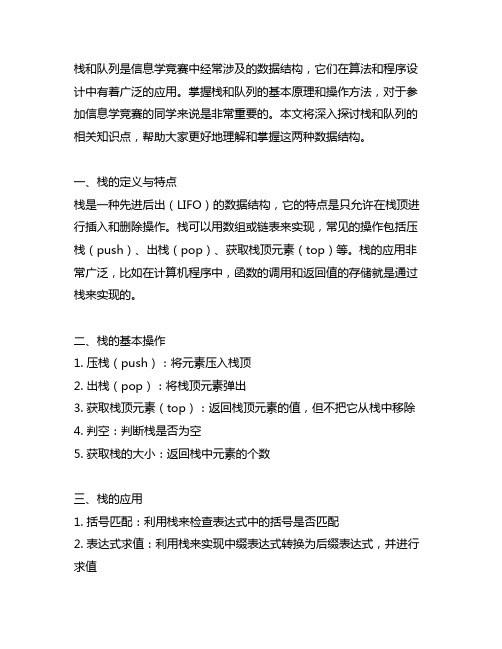
栈和队列是信息学竞赛中经常涉及的数据结构,它们在算法和程序设计中有着广泛的应用。
掌握栈和队列的基本原理和操作方法,对于参加信息学竞赛的同学来说是非常重要的。
本文将深入探讨栈和队列的相关知识点,帮助大家更好地理解和掌握这两种数据结构。
一、栈的定义与特点栈是一种先进后出(LIFO)的数据结构,它的特点是只允许在栈顶进行插入和删除操作。
栈可以用数组或链表来实现,常见的操作包括压栈(push)、出栈(pop)、获取栈顶元素(top)等。
栈的应用非常广泛,比如在计算机程序中,函数的调用和返回值的存储就是通过栈来实现的。
二、栈的基本操作1. 压栈(push):将元素压入栈顶2. 出栈(pop):将栈顶元素弹出3. 获取栈顶元素(top):返回栈顶元素的值,但不把它从栈中移除4. 判空:判断栈是否为空5. 获取栈的大小:返回栈中元素的个数三、栈的应用1. 括号匹配:利用栈来检查表达式中的括号是否匹配2. 表达式求值:利用栈来实现中缀表达式转换为后缀表达式,并进行求值3. 迷宫求解:利用栈来实现迷宫的路径搜索4. 回溯算法:在深度优先搜索和递归算法中,通常会用到栈来保存状态信息四、队列的定义与特点队列是一种先进先出(FIFO)的数据结构,它的特点是只允许在队尾进行插入操作,在队首进行删除操作。
队列同样可以用数组或链表来实现,常见的操作包括入队(enqueue)、出队(dequeue)、获取队首元素(front)、获取队尾元素(rear)等。
队列在计算机领域也有着广泛的应用,比如线程池、消息队列等都可以用队列来实现。
五、队列的基本操作1. 入队(enqueue):将元素插入到队列的末尾2. 出队(dequeue):从队列的头部删除一个元素3. 获取队首元素(front):返回队列的头部元素的值4. 获取队尾元素(rear):返回队列的尾部元素的值5. 判空:判断队列是否为空6. 获取队列的大小:返回队列中元素的个数六、队列的应用1. 广度优先搜索算法(BFS):在图的搜索中,通常会用队列来实现BFS算法2. 线程池:利用队列来实现任务的调度3. 消息队列:在分布式系统中,常常会用队列来进行消息的传递4. 最近最少使用(LRU)缓存算法:利用队列实现LRU缓存淘汰在信息学竞赛中,栈和队列的相关题目经常出现,并且有一定的难度。
吉林大学数据结构_堆栈、队列
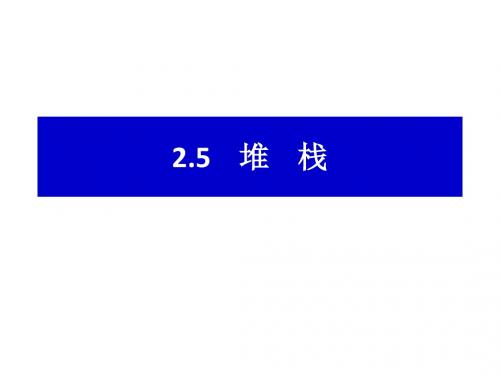
链式栈——入栈算法
算法Push(item)
/*向栈顶指针为top的链式栈中压入一个元素item*/
P1. [创建新结点]
s<=AVAIL. data(s) ←item. next(s) ←top.
P2. [更新栈顶指针]
top ←s. ▍
链式栈——出栈算法
算法Pop(.item)
/*从栈顶指针为top的链式栈中弹出栈顶元素,并存放在变量 item中*/
链式队列——存取队首元素
算法QFront(.item) /*读取队首元素值并将其存入item*/ QD1.[队列空?] if front=null then (print “队空”. Return.) QD2.[存取] item ← data(front). ▍
P1. [栈空?]
IF top=NULL THEN (PRINT “栈空无法弹出”. RETRUN.)
P2. [出栈]
item ←data(top). q ←next(top). AVAIL<=top. top ←q. ▍
链式栈——存取栈顶元素
算法Peek(.item) /*将栈顶指针为top的链式栈的栈顶元素存放 在变量item中*/ P1. [栈空?] IF top=NULL THEN (PRINT “栈空”. RETRUN.) P2. [存取栈顶] item ←data(top). ▍
链式栈——栈清空
算法Clear() /*将栈顶指针为top的链式栈清空*/ C1. [逐一出栈,直至栈空] WHILE top≠NULL DO ( q ←next(top). AVAIL<=top. top ←q. )▍
顺序栈与链式栈的比较-1
• 空间复杂性:
第三章栈和队列
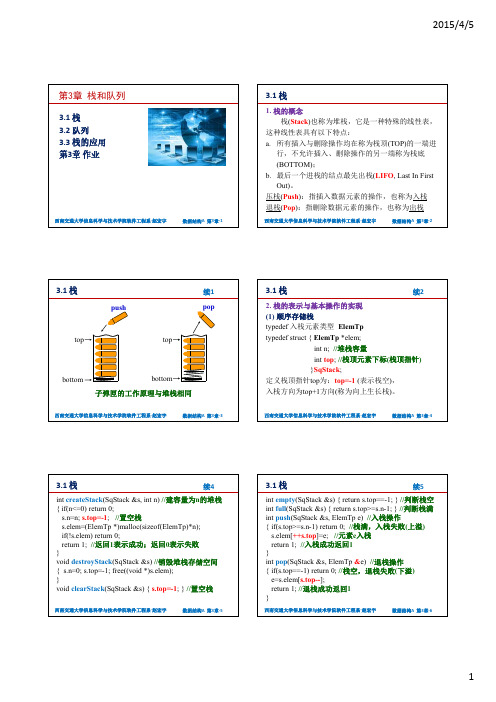
续8
//循环队列实现方案二 在SqQueue结构体中增设计数变量c,记录队列中当前 元素个数 void clearQueue(SqQueue &q) { q.r=q.f=-1; q.c=0; //r=f=-1~n-1区间任意整数均可 } int empty(SqQueue &q) { return q.c==0; } int full(SqQueue &q) { return q.c==q.n; } //队空、队满时q.f==q.r均为真 //优点:队满时没有空闲元素位置(充分利用了空间)
西南交通大学信息科学与技术学院软件工程系‐赵宏宇 数据结构A 第3章‐19
西南交通大学信息科学与技术学院软件工程系‐赵宏宇
数据结构A 第3章‐20
3.3 栈的应用
续1
3.3 栈的应用
续2
2. 栈与递归 (1) 递归程序的存储空间消耗 由于函数调用的指令返回地址、形式参数以及断 点状态均用系统堆栈实现存储,因此递归调用的层次 数(深度)决定了系统堆栈必须保留的存储空间容量大小。 例1 以下函数用递归法实现n元一维数组元素逆序存储, 试分析所需栈的深度。 void reverse(ElemTp a[], int i, int j) //数组a下标范围i..j实现元素逆序存储 { if(i<j) { a[i]a[j]; reverse(a, i+1, j-1); } }
西南交通大学信息科学与技术学院软件工程系‐赵宏宇 数据结构A 第3章‐7
3. 堆栈习题举例 例1 若元素入栈次序为ABC,写出所有可能的元素出栈 次序。 答: 所有可能的元素出栈次序共5种,即 ABC 操作PXPXPX (P表示入栈,X表示退栈) ACB PXPPXX BAC PPXXPX BCA PPXPXX CBA PPPXXX
《刘大有数据结构》 chapter 4 线性表、堆栈和队列
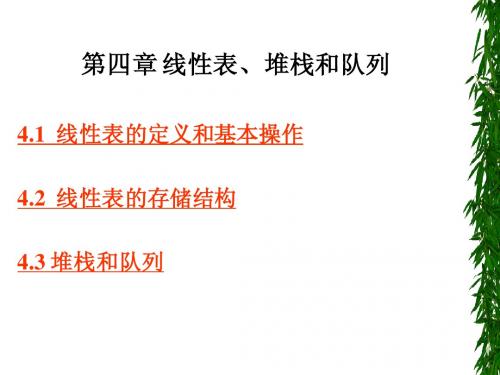
4. 遍历链表 所谓遍历一个结构, 遍历一个结构 所谓遍历一个结构,是指按一定的次序访问结构中的所有 结点,且每个结点恰被访问一次。遍历链表, 结点,且每个结点恰被访问一次。遍历链表,就是按一定 次序访问链表的所有结点。 次序访问链表的所有结点。 算法PrintList(head) 算法 ( ) PL 1 [取表头,计数器初始化 取表头, 取表头 计数器初始化] currptr ← head . count ← 0 . PL 2 [遍历并输出链表结点的 遍历并输出链表结点的data值] 值 遍历并输出链表结点的 WHILE(currptr ≠ NULL) DO ( ) ( PRINT( data(currptr) ). count ← count + 1. ( ( ) IF(MOD(count,5)= 0 ) THEN PRINT . ( ( , ) currptr ← next(currptr). ( ) )▌
header
next
data next
data next
…
data next
图 4.5 循环链表
由于单链表和循环链表中对头结点的定义是不同的, 由于单链表和循环链表中对头结点的定义是不同的,因而 对于单链表和循环链表而言, 对于单链表和循环链表而言,检测链表是否为空的方法并 不相同: 不相同: 单链表: 单链表: 循环链表: 循环链表: head = = NULL header > next = = header
线性表、 第四章 线性表、堆栈和队列
4.1 线性表的定义和基本操作 4.2 线性表的存储结构 4.3 堆栈和队列
4.1 线性表的定义和基本操作
定义4.1 一个线性表是由零个或多个具有相同类型 一个线性表 线性表是由零个或多个具有相同类型 定义 的结点组成的有序集合。 我们用( 的结点组成的有序集合 。 我们用 ( a0 , a1 , …, , an-1 ) 来表示一个线性表 , n为一个自然数 。 当 来表示一个线性表, 为一个自然数 为一个自然数。 n>0时 n>0 时 , a0 称为表的 始结点 , an-1 称为表的 终结点 , 称为表的始结点 始结点, 称为表的终结点 终结点, ai称为ai+1的前趋结点,ai+1称为ai的后继结点;当 称为 前趋结点, 称为 后继结点; n=0时 , 表中有零个结点 , 包含零个结点的线性 时 表中有零个结点, 表被称为空表 空表。 表被称为空表。
c语言堆栈和队列函数大全
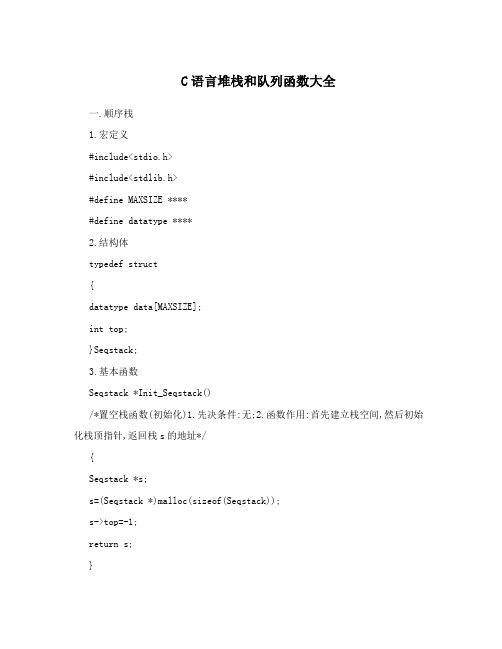
C语言堆栈和队列函数大全一.顺序栈1.宏定义#include<stdio.h>#include<stdlib.h>#define MAXSIZE ****#define datatype ****2.结构体typedef struct{datatype data[MAXSIZE];int top;}Seqstack;3.基本函数Seqstack *Init_Seqstack()/*置空栈函数(初始化)1.先决条件:无;2.函数作用:首先建立栈空间,然后初始化栈顶指针,返回栈s的地址*/{Seqstack *s;s=(Seqstack *)malloc(sizeof(Seqstack));s->top=-1;return s;}int Empty_Seqstack(Seqstack *s) /*判栈空函数1.先决条件:初始化顺序栈;2.函数作用:判断栈是否为空,空返回1,不空返回0*/ {if(s->top==-1) return 1;else return 0;}int Push_Seqstack(Seqstack *s,datatype x) /*入栈函数1.先决条件:初始化顺序栈2.函数作用:将数据x入栈,栈满则不能,成功返回1,因栈满失败返回0*/ {if(s->top==MAXSIZE-1)return 0;s->top=s->top+1;s->data[s->top]=x;return 1;}int Pop_Seqstack(Seqstack *s,datatype *x) acidity, mL.; M--calibration of the molar concentration of sodium hydroxide standard solution, moI/L; V--amount of the volume of sodium hydroxide standard solution, Ml; M--the weight of the sample, g. Such as poor meets the requirements, take the arithmetic mean of the second determination as a result. Results one decimal. 6, allowing differential analyst simultaneously or in quick succession for the second determination, the absolute value of the difference of the results. This value should be no more than 1.0. 1, definitions and principles for determination of ash in starches, starch and ash: starch samples of ash the residue obtainedafter weight. Original sample residue weight of sample weight or weight expressed as a percentage of the dry weight of the sample. Samples ofash at 900 ? high temperature until ashing sample ... The Crucible: determination of Platinum or other conditions of the affected material, capacity of 50mL. Dryer: has effectively adequate drying agent and-perforated metal plate or porcelain. Ashing furnaces: device for controlling and regulating temperature, offers 900 incineration temperature of 25 c. Analytical balance. Electric hot plate or Bunsen. 3, crucible of analysis steps preparation: Crucible must first wash with boiling dilute hydrochloric acid, then wash with a lot of water and then rinse with distilled water. Wash the Crucible within ashing furnace, heated at 900 to 25 ? 30min, and in the desiccator to cool to room temperature and then weighing,/*出栈函数1.先决条件:初始化顺序栈2.函数作用:从栈中出一个数据,并将其存放到x中,成功返回1,因栈空失败返回0*/{if(s->top==-1)return 0;*x=s->data[s->top];s->top--;return 1;}int Top_Seqstack(Seqstack *s,datatype *x)/*取栈顶元素函数1.先决条件:初始化顺序栈2.函数作用:取栈顶元素,并把其存放到x中,成功返回1,因栈空失败返回0*/{if(s->top==-1)return 0;*x=s->data[s->top];return 1;}int Printf_Seqstack(Seqstack *s) /*遍历顺序栈函数1.先决条件:初始化顺序栈2.函数作用:遍历顺序栈,成功返回1*/ {int i,j=0;for(i=s->top;i>=0;i--){printf("%d ",s->data[i]);/*因datatype不同而不同*/j++;if(j%10==0)printf("\n");}printf("\n");return 1;}int Conversation_Seqstack(int N,int r) /*数制转换函数(顺序栈)1.先决条件:具有置空栈,入栈,出栈函数2.函数作用:将N转换为r进制的数*/{Seqstack *s;datatype x;printf("%d转为%d进制的数为:",N,r);/*以后可以删除去*/s=Init_Seqstack();do{Push_Seqstack(s,N%r);N=N/r;acidity, mL.; M--calibration of the molar concentration of sodium hydroxide standard solution, moI/L; V--amount of the volume of sodium hydroxide standard solution, Ml; M--the weight of the sample, g. Such as poor meets the requirements, take the arithmetic mean of the second determination as a result. Results one decimal. 6, allowing differential analyst simultaneously or in quick succession for the second determination, the absolute value of the difference of the results. This value should be no more than 1.0. 1, definitions and principles for determination of ash in starches, starch and ash: starch samples of ash the residue obtained after weight. Original sample residue weight of sample weight or weight expressed as a percentage of the dry weight of the sample. Samples of ash at 900 ? high temperature until ashing sample ... The Crucible: determination of Platinum or other conditions of the affected material, capacity of 50mL. Dryer: has effectivelyadequate drying agent and-perforated metal plate or porcelain. Ashing furnaces: device for controlling and regulating temperature, offers 900 incineration temperature of 25 c. Analytical balance. Electric hot plate or Bunsen. 3, crucible of analysis steps preparation: Crucible mustfirst wash with boiling dilute hydrochloric acid, then wash with a lot of water and then rinse with distilled water. Wash the Crucible within ashing furnace, heated at 900 to 25 ? 30min, and in the desiccator to cool to room temperature and then weighing,}while(N);while(Pop_Seqstack(s,&x)){if(x>=10)/*为了能转为十进制以上的*/printf("%c",x+55);elseprintf("%d",x);}free(s);/*释放顺序栈*/printf("\n");return 1;}4.主函数int main(){Seqstack *s;int choice;datatype x;do{printf("************************************************************ ****\n");printf("1.置空栈 2.判栈空 3.入栈 4.出栈 5.取栈顶元素 6.遍历 7.退出\n");printf("************************************************************ ****\n");printf("请输入选择(1~7):");scanf("%d",&choice);getchar();switch(choice){case 1:s=Init_Seqstack();if(s)printf("置空栈成功!\n");break;case 2:if(Empty_Seqstack(s))printf("此为空栈.\n");elseprintf("此不为空栈.\n");;break;case 3:printf("请输入一个整数:");scanf("%d",&x);if(Push_Seqstack(s,x))printf("入栈成功.\n");elseprintf("栈已满,无法入栈.\n");;break;case 4:if(Pop_Seqstack(s,&x)) acidity, mL.; M--calibration of the molar concentration of sodium hydroxide standard solution, moI/L; V--amount of the volume of sodium hydroxide standard solution, Ml; M--the weight of the sample, g. Such as poor meets the requirements, take the arithmetic mean of the second determination as a result. Results one decimal. 6, allowing differential analyst simultaneously or in quick succession for the second determination, the absolute value of the difference of the results. This value should be no more than 1.0. 1, definitions and principles for determination of ash in starches, starch and ash: starch samples of ash the residue obtained after weight. Original sample residue weight of sample weight or weight expressed as a percentage of the dry weight of the sample. Samples of ash at 900 ? high temperature until ashing sample ... The Crucible: determination of Platinum or other conditions of the affected material, capacity of 50mL. Dryer: has effectively adequate drying agent and-perforated metal plate or porcelain. Ashing furnaces: device for controlling and regulating temperature, offers 900 incineration temperature of 25 c. Analytical balance. Electric hot plate or Bunsen. 3, crucible of analysis steps preparation: Crucible must first wash with boiling dilute hydrochloric acid, then wash with a lot of water and then rinse with distilled water.Wash the Crucible within ashing furnace, heated at 900 to 25 ? 30min, and in the desiccator to cool to room temperature and then weighing, printf("出栈成功,出栈元素为:%d\n",x);elseprintf("出栈失败,因栈为空.\n");break;case 5:if(Top_Seqstack(s,&x))printf("取栈顶元素成功,栈顶元素为:%d\n",x);elseprintf("取栈顶元素失败,因栈为空.\n");break;case 6:Printf_Seqstack(s);break;case 7:printf("谢谢使用!\n");break;default :printf("输入错误,请重新输入!\n");break;}}while(choice!=7);return 0;}二.链栈1.宏定义#include<stdio.h>#include<stdlib.h>#define datatype ****2.结构体typedef struct snode{datatype data;struct snode *next;}Stacknode,*Linkstack;3.基本函数Linkstack Init_Linkstack()/*初始化栈函数1.先决条件:无2.函数作用:初始化链栈,返回top地址*/ { Linkstack top;top=(Linkstack)malloc(sizeof(Stacknode));top->next=NULL;return top;}int Empty_Linkstack(Linkstack top) /*判栈空函数1.先决条件:初始化链栈2.函数作用:判断栈是否为空,空返回1,不空返回0*/{if(top->next==NULL)acidity, mL.; M--calibration of the molar concentration of sodium hydroxide standard solution, moI/L; V--amount of the volume of sodium hydroxide standard solution, Ml; M--the weight of the sample, g. Such as poor meets the requirements, take the arithmetic mean of the second determination as a result. Results one decimal. 6, allowing differential analyst simultaneously or in quick succession for the second determination, the absolute value of the difference of the results. This value should be no more than 1.0. 1, definitions and principles fordetermination of ash in starches, starch and ash: starch samples of ash the residue obtained after weight. Original sample residue weight of sample weight or weight expressed as a percentage of the dry weight of the sample. Samples of ash at 900 ? high temperature until ashing sample ... The Crucible: determination of Platinum or other conditions of the affected material, capacity of 50mL. Dryer: has effectively adequate drying agent and-perforated metal plate or porcelain. Ashing furnaces: device for controlling and regulating temperature, offers 900 incineration temperature of 25 c. Analytical balance. Electric hot plate or Bunsen. 3, crucible of analysis steps preparation: Crucible mustfirst wash with boiling dilute hydrochloric acid, then wash with a lot of water and then rinse with distilled water. Wash the Crucible within ashing furnace, heated at 900 to 25 ? 30min, and in the desiccator to cool to room temperature and then weighing,return 1;else return 0;}int Push_Linkstack(Linkstack top,datatype x) /*入栈函数1.先决条件:初始化链栈2.函数作用:将数据x入栈,成功返回1,失败返回0*/ { Stacknode *p;p=(Stacknode *)malloc(sizeof(Stacknode));p->data=x;p->next=top->next;top->next=p;return 1;}int Pop_Linkstack(Linkstack top,datatype *x) /*出栈函数1.先决条件:初始化链栈2.函数作用:若栈空退出,若没空则将数据出栈,并将其存放到x中,成功返回1,因栈空失败返回0*/{if(top->next==NULL)return 0;Stacknode *p=top->next;*x=p->data;top->next=p->next;free(p);return 1;}int Top_Linkstack(Linkstack top,datatype *x) /*取栈顶元素函数1.先决条件:初始化链栈2.函数作用:取栈顶元素并放到x中,成功返回1,因栈空失败返回0*/{if(top->next==NULL)return 0;*x=top->next->data;return 1;}int Printf_Linkstack(Linkstack top) /*遍历链栈函数1.先决条件:初始化链栈2.函数作用:遍历链栈,成功返回1*/ {Stacknode *p=top->next;int j=0;while(p){printf("%d ",p->data);/*因datatype不同而不同*/j++;if(j%10==0)acidity, mL.; M--calibration of the molar concentration of sodium hydroxide standard solution, moI/L; V--amount of the volume of sodium hydroxide standard solution, Ml; M--the weight of the sample, g. Such as poor meets the requirements, take the arithmetic mean of the second determination as a result. Results one decimal. 6, allowing differential analyst simultaneously or in quick succession for the second determination, the absolute value of the difference of the results. This value should be no more than 1.0. 1, definitions and principles for determination of ash in starches, starch and ash: starch samples of ash the residue obtained after weight. Original sample residue weight of sample weight or weight expressed as a percentage of the dry weight of the sample. Samples of ash at 900 ? high temperature until ashing sample ... The Crucible: determination of Platinum or other conditions of the affected material, capacity of 50mL. Dryer: has effectively adequate drying agent and-perforated metal plate or porcelain. Ashingfurnaces: device for controlling and regulating temperature, offers 900 incineration temperature of 25 c. Analytical balance. Electric hot plate or Bunsen. 3, crucible of analysis steps preparation: Crucible mustfirst wash with boiling dilute hydrochloric acid, then wash with a lot of water and then rinse with distilled water. Wash the Crucible within ashing furnace, heated at 900 to 25 ? 30min, and in the desiccator to cool to room temperature and then weighing,printf("\n");p=p->next;}printf("\n");return 1;}int Conversation_Linkstack(int N,int r)/*数制转换函数(链栈)1.先决条件:具有置空栈,入栈,出栈函数2.函数作用:将N转换为r进制的数*/{Linkstack top;datatype x;printf("%d转为%d进制的数为:",N,r);/*以后可以删除去*/top=Init_Linkstack();do{Push_Linkstack(top,N%r);N=N/r;}while(N);while(Pop_Linkstack(top,&x)){if(x>=10)/*为了能转为十进制以上的*/printf("%c",x+55);elseprintf("%d",x);}printf("\n");free(top);/*释放栈顶空间*/return 1;}4.主函数int main(){Linkstack top;int choice;datatype x;do{printf("************************************************************ ****\n");printf("1.置空栈 2.判栈空 3.入栈 4.出栈 5.取栈顶元素 6.遍历 7.退出\n");printf("************************************************************ ****\n");printf("请输入选择(1~7):");acidity, mL.; M--calibration of the molar concentration of sodium hydroxide standard solution, moI/L; V--amount of the volume of sodium hydroxide standard solution, Ml; M--the weight of the sample, g. Such as poor meets the requirements, take the arithmetic mean of the second determination as a result. Results one decimal. 6, allowing differential analyst simultaneously or in quick succession for the second determination, the absolute value of the difference of the results. This value should be no more than 1.0. 1, definitions and principles for determination of ash in starches, starch and ash: starch samples of ash the residue obtained after weight. Original sample residue weight of sample weight or weight expressed as a percentage of the dry weight of the sample. Samples of ash at 900 ? high temperature until ashing sample ... The Crucible: determination of Platinum or other conditions of the affected material, capacity of 50mL. Dryer: has effectively adequate drying agent and-perforated metal plate or porcelain. Ashing furnaces: device for controlling and regulating temperature, offers 900 incineration temperature of 25 c. Analytical balance. Electric hot plate or Bunsen. 3, crucible of analysis steps preparation: Crucible mustfirst wash with boiling dilute hydrochloric acid, then wash with a lotof water and then rinse with distilled water. Wash the Crucible within ashing furnace, heated at 900 to 25 ? 30min, and in the desiccator to cool to room temperature and then weighing,scanf("%d",&choice);getchar();switch(choice){case 1:top=Init_Linkstack();if(top)printf("置空栈成功!\n");break;case 2:if(Empty_Linkstack(top))printf("此为空栈.\n");elseprintf("此不为空栈.\n");;break;case 3:printf("请输入一个整数:");scanf("%d",&x);if(Push_Linkstack(top,x))printf("入栈成功.\n");elseprintf("栈已满,无法入栈.\n");;break;case 4:if(Pop_Linkstack(top,&x))printf("出栈成功,出栈元素为:%d\n",x);elseprintf("出栈失败,因栈为空.\n");break;case 5:if(Top_Linkstack(top,&x))printf("取栈顶元素成功,栈顶元素为:%d\n",x);elseprintf("取栈顶元素失败,因栈为空.\n");break;case 6:Printf_Linkstack(top);break;case 7:printf("谢谢使用!\n");break;default :printf("输入错误,请重新输入!\n");break;}}while(choice!=7);return 0;}二.队列1.宏定义2.结构体3.基本函数4.主函数acidity, mL.; M--calibration of the molar concentration of sodium hydroxide standard solution, moI/L; V--amount of the volume of sodium hydroxide standard solution, Ml; M--the weight of the sample, g. Such as poor meets the requirements, take the arithmetic mean of the second determination as a result. Results one decimal. 6, allowing differential analyst simultaneously or in quick succession for the second determination, the absolute value of the difference of the results. Thisvalue should be no more than 1.0. 1, definitions and principles for determination of ash in starches, starch and ash: starch samples of ash the residue obtained after weight. Original sample residue weight of sample weight or weight expressed as a percentage of the dry weight of the sample. Samples of ash at 900 ? high temperature until ashing sample ... The Crucible: determination of Platinum or other conditions of the affected material, capacity of 50mL. Dryer: has effectively adequate drying agent and-perforated metal plate or porcelain. Ashing furnaces: device for controlling and regulating temperature, offers 900 incineration temperature of 25 c. Analytical balance. Electric hot plate or Bunsen. 3, crucible of analysis steps preparation: Crucible mustfirst wash with boiling dilute hydrochloric acid, then wash with a lot of water and then rinse with distilled water. Wash the Crucible within ashing furnace, heated at 900 to 25 ? 30min, and in the desiccator to cool to room temperature and then weighing,。
栈与队列,各有异同。
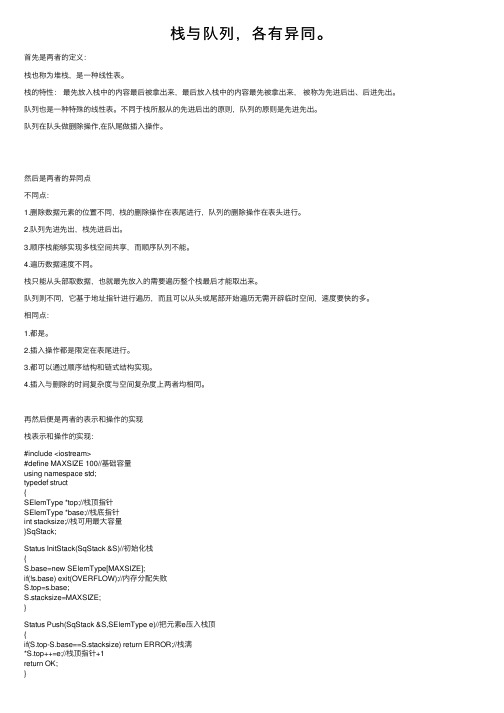
栈与队列,各有异同。
⾸先是两者的定义:栈也称为堆栈,是⼀种线性表。
栈的特性:最先放⼊栈中的内容最后被拿出来,最后放⼊栈中的内容最先被拿出来,被称为先进后出、后进先出。
队列也是⼀种特殊的线性表。
不同于栈所服从的先进后出的原则,队列的原则是先进先出。
队列在队头做删除操作,在队尾做插⼊操作。
然后是两者的异同点不同点:1.删除数据元素的位置不同,栈的删除操作在表尾进⾏,队列的删除操作在表头进⾏。
2.队列先进先出,栈先进后出。
3.顺序栈能够实现多栈空间共享,⽽顺序队列不能。
4.遍历数据速度不同。
栈只能从头部取数据,也就最先放⼊的需要遍历整个栈最后才能取出来。
队列则不同,它基于地址指针进⾏遍历,⽽且可以从头或尾部开始遍历⽆需开辟临时空间,速度要快的多。
相同点:1.都是。
2.插⼊操作都是限定在表尾进⾏。
3.都可以通过顺序结构和链式结构实现。
4.插⼊与删除的时间复杂度与空间复杂度上两者均相同。
再然后便是两者的表⽰和操作的实现栈表⽰和操作的实现:#include <iostream>#define MAXSIZE 100//基础容量using namespace std;typedef struct{SElemType *top;//栈顶指针SElemType *base;//栈底指针int stacksize;//栈可⽤最⼤容量}SqStack;Status InitStack(SqStack &S)//初始化栈{S.base=new SElemType[MAXSIZE];if(!s.base) exit(OVERFLOW);//内存分配失败S.top=s.base;S.stacksize=MAXSIZE;}Status Push(SqStack &S,SElemType e)//把元素e压⼊栈顶{if(S.top-S.base==S.stacksize) return ERROR;//栈满*S.top++=e;//栈顶指针+1return OK;}Status Pop(SqStack &s,SElemType &e)//取出栈顶元素,并删除栈顶{if(S.top==S.base)//top与base重合时,栈为空return ERROR;e=*--S.top;return OK;}SElemType GetTop(SqStack S){if(S.top!=S.base)return *(S.top-1);}队列表⽰和操作的实现:#ifndef STATICQUEUE_H_INCLUDED#define STATICQUEUE_H_INCLUDEDtemplate<class T>class StaticQueue{public:StaticQueue();StaticQueue(int size);~StaticQueue();void enqueue(T data);T dequeue();bool isEmpty();bool isFull();int count();void display();private:int rear;int front;int size;const static int DEFAULT;T* queue;};这些在课本上都有,下⾯说说遇到的问题:对于作业3,可以说是屡战屡败,屡败屡战了,先是⼀点思路都没有,再到后来⽼师提⽰后有⼀点思路,但还是错误百出,再到后来参照书上的⽅法,还是错误,最后终于发现问题。
数据结构与算法:Python语言描述 栈和队列 ppt课件
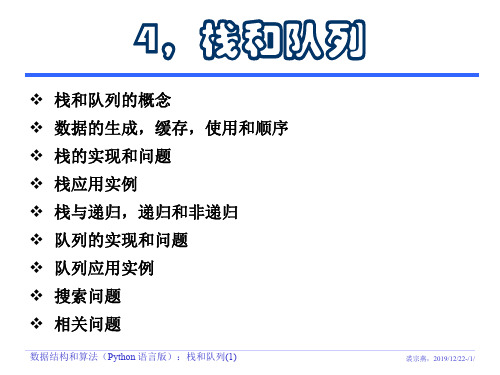
裘宗燕,2019/12/22-/10/
栈的应用
栈是算法和程序里最常用的辅助结构,基本用途基于两方面: 用栈可以很方便地保存和取用信息,因此常作为算法或程序里的辅 助存储结构,临时保存信息,供后面的操作使用 利用栈后进先出的特点,可以得到特定的存储和取用顺序 许多实际运用结合了这两方面的特性
配对的原则
遇到的闭括号应该匹配此前遇到的最近的尚未匹配的对应开括号
由于多种/多次/可能嵌套,为检查配对,遇到的开括号必须保存
由于括号可能嵌套,需要逐对匹配,闭括号应与前面最近的尚未有 匹配的开括号匹配,后面括号应与更前面次近的括号匹配
可以删除匹配的括号,为后面的匹配做好准备
后遇到并保存的开括号应该先删除,这就是后进先出,而且要按照出现 顺序,显然应该/可以用一个栈保存开括号
概述
栈和队列保证元素存取之间的时间关系,特点是:
栈是保证缓存元素后进先出(Last In First Out,LIFO)的结构
队列是保证缓存元素的先进先出(先存者先用,First In First Out, FIFO)关系的结构
对于栈和队列,任何时候,下次访问或删除的元素都默认地唯一确定。 只有新的存入或删除(弹出)操作可能改变下次的默认元素
self._elems = [] # 所有栈操作都映射到list操作
def is_empty(self):
return self._elems == []
def top(self):
if self._elems == []:
raise StackUnderflow("in SStack.top()")
return self._elems[-1]
数据结构-使用C语言 朱战立 第3章堆栈和队列
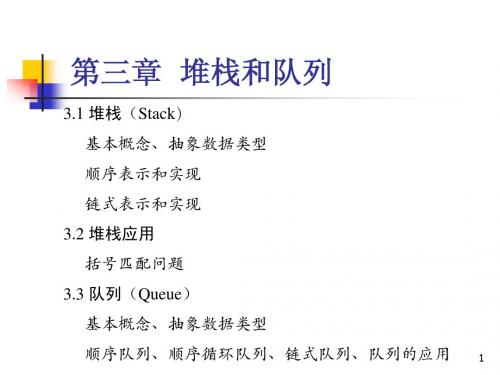
top
D top C B A
D C B A
top
D C B A
top
顺序栈出栈函数的核心语句: S->top --; d = S->stack[S->top];
17
例5、 设依次进入一个栈的元素序列为c,a,b,d,则 可得到出栈的元素序列是:
A)a,b,c,d C)b,c,d,a
B)c,d,a,b D)a,c,d,b
初始化堆栈S 堆栈S非空否 入栈 出栈 取栈顶数据元素
11
二、堆栈的顺序表示和实现 1、顺序(堆)栈
顺序存储结构的堆栈。
顺序栈S an an-1 …… 栈顶top
2、顺序栈的存储结构
它是利用一组地址连续的存储 单元依次存放自栈底到栈顶的数据 元素,同时设指针top指示当前栈顶 位置。
ai …… a1 a0
具体方法:顺序扫描算术表达式(表现为一个字符串), 当遇到三种类型的左括号时让该括号进栈; 1. 当扫描到某一种类型的右括号时,比较当前栈顶括号是 否与之匹配,若匹配则退栈继续进行判断; 2. 若当前栈顶括号与当前扫描的括号不相同,则左右括号 配对次序不正确; 3. 若字符串当前为某种类型左括号而堆栈已空,则右括号 多于左括号; 4. 字符串循环扫描结束时,若堆栈非空(即堆栈中尚有某 种类型左括号),则说明左括号多于右括号;否则,左 右括号匹配正确。
14
顺序栈S
高地址
栈顶top
an an-1 …… ai …… a1 a0 入栈口诀:堆栈指针top “先 压后加” : S[top++]=an 栈底base 出栈口诀:堆栈指针top “先 减后弹” : e=S[--top]
低地址
栈不存在的条件: base=NULL; 栈为空的条件 : base=top或top<=0; 栈满的条件 : top-base=MaxSize;
大学《数据结构》第三章:栈和队列-第一节-栈

第一节栈
一、栈的定义及其运算
1、栈的定义
栈(Stack):是限定在表的一端进行插入和删除运算的线性表,通常将插入、删除的一端称为栈项(top),另一端称为栈底(bottom)。
不含元素的空表称为空栈。
栈的修改是按后进先出的原则进行的,因此,栈又称为后进先出(Last In First Out)的线性表,简称为LIFO表。
真题选解
(例题·填空题)1、如图所示,设输入元素的顺序是(A,B,C,D),通过栈的变换,在输出端可得到各种排列。
若输出序列的第一个元素为D,则输出序列为。
隐藏答案
【答案】DCBA
【解析】根据堆栈"先进后出"的原则,若输出序列的第一个元素为D,则ABCD入栈,输出序列为DCBA
2、栈的基本运算
(1)置空栈InitStack(&S):构造一个空栈S。
Java中栈和队列的使用及区别

poll() :检索并删除此队列的头部,如果此队列为空,则返回null。
E
remove() :检索并删除此队列的头。
3、 Deque(双端队列 /栈)
Deque是双端队列的接口,也是我们使用最多的队列,既可以当作栈也可以当作队列使用。
Deque是支持在两端插入和删除元素的线性集合,双端队列是“双端队列”(double ended queue)的缩写。大多数Deque对它们可能包含 的元素数量没有固定的限制,但是此接口支持容量受限的双端队列以及没有固定大小限制的双端队列。此接口定义访问双端队列两端的元素 的方,提供了用于插入,删除和检查元素的方法。这些方法中的每一种都以两种形式存在:一种在操作失败时引发异常,另一种返回一个特 殊值(根据操作为null或false)。插入操作的后一种形式是专为容量受限的Deque实现而设计的。在大多数实现中,插入操作不会失败。
简单来说,PriorityQueue就是一个优先级队列,在我们需要堆的时候可以使用PriorityQueue当作堆进行使用,因为PriorityQueue继承
自AbstractQueue,而AbstractQueue实现Queue,所以PriorityQueue的方法和Queue差不多,使用起来也比较方便。
5.3 适 用 场 景 不 同
栈:具有记忆能力,使用于括号求解、表达式转换、函数递归和调用的实现、深度优先搜索遍历、浏览器后退功能等,需要记忆原来数 据内容的场景。 队列:可以进行有顺序的处理,如计算机系统中各种资源的管理、消息缓冲器的管理、广度优先搜索等场景。
6、 总 结
在不考虑多线程的情况下 使用栈就是使用Deque的实现类 使用队列就使用Deque的实现类 使用堆就使用PriorityQueue。
数据结构第三章-栈和队列(严蔚敏)

}
s
top
top
…... 栈底 ^
x
24
出栈算法
LinkStack Pop_LinkStack (LinkStack DataType *x) { StackNode *p; if (top= =NULL)return NULL; else {*x = top->data; p = top; top = top->next; top top free (p); a return top;} p } x a top,
11
顺序栈
栈的顺序存储结构简称为顺序栈,是利用一组地址 连续的存储单元依次存放自栈底到栈顶的数据元素,同 时附设指针top指向实际栈顶后的空位置。
12
顺序表和顺序栈的操作区别
以线性表 S= (a1 , a2 , …. , an-1 , an )为例 顺序栈S an+1 高地址 顺序表S 高地址 表尾 an an …… …… S[i] ai ai …… …… a2 低地址 a1 a2 低地址 表头 a1 栈顶top 栈顶top
Stacksize 指示栈的当前可使用的最大容量。栈的初始化操作为: 按设定的初始分配量进行第一次存储分配; base可称为栈底指针,在顺序栈中它始终指向栈底的位置,若 base的值为NULL,则表明栈结构不存在。 top为栈顶指针,其初值指向栈底,即top=base可作为栈空的标 记; 每当插入新的栈顶元素时(入栈),堆栈指针top先压后加 (S[top++]=an+1); ; 删除栈顶元素时(出栈),堆栈指针top先减后弹
B
A
19
顺序栈入栈 int push(SqStack &s, SElemType e){ if (s.top-s.base>=s.stacksize){//栈满的判断 s.base=(SElemTYpe*) realloc(s.base,s.stacksize+ STACKINCREMENT)*sizeof(SElemType)); if (!s.base) exit (OVERFLOW); s.top=s.base+s.stacksize; s.stacksize+=STACKINCREMENT; top } *s.top++=e; //入栈( *s.top=e; *s.top++); return OK; } base
第3章 限定性线性表——栈和队列
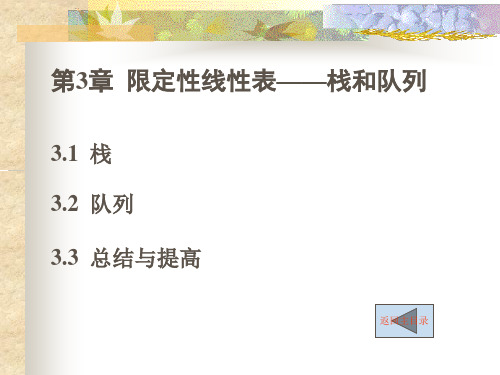
两栈共享技术(双端栈):
主要利用了栈“栈底位置不变,而栈顶位置动态变
化”的特性。首先为两个栈申请一个共享的一维数 组空间S[M],将两个栈的栈底分别放在一维数组的 两端,分别是0,M-1。
共享栈的空间示意为:top[0]和top[1]分别为两个 栈顶指示器 。
Stack:0
M-1
top[0]
top[1]
(1)第i号栈的进栈操作 int pushi(LinkStack top[M], int i, StackElementType x) { /*将元素x进入第i号链栈*/
LinkStackNode *temp; temp=(LinkStackNode * )malloc(sizeof(LinkStackNode)); if(temp==NULL) return(FALSE); /* 申请空间失败 */ temp->data=x; temp->next=top[i]->next; top[i]->next=temp; /* 修改当前栈顶指针 */ return(TRUE); }
case 1:if(S->top[1]==M) return(FALSE);
*x=S->Stack[S->top[1]];S->top[1]++;break;
default: return(FALSE);
}
return(TRUE);
返回主目录
}
【思考题】
说明读栈顶与退栈顶的处理异同,并标明将已知 的退栈顶算法改为读栈顶算法时应做哪些改动。
返回主目录
链栈的进栈操作
int Push(LinkStack top, StackElementType x)
数据结构复习资料 第4章
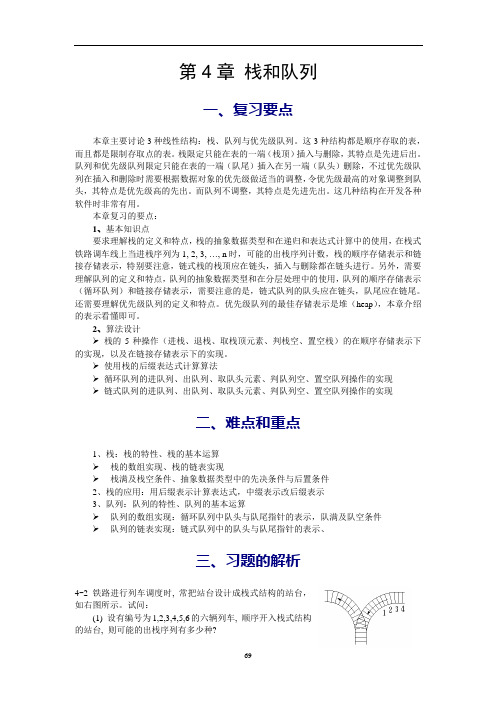
第4章栈和队列一、复习要点本章主要讨论3种线性结构:栈、队列与优先级队列。
这3种结构都是顺序存取的表,而且都是限制存取点的表。
栈限定只能在表的一端(栈顶)插入与删除,其特点是先进后出。
队列和优先级队列限定只能在表的一端(队尾)插入在另一端(队头)删除,不过优先级队列在插入和删除时需要根据数据对象的优先级做适当的调整,令优先级最高的对象调整到队头,其特点是优先级高的先出。
而队列不调整,其特点是先进先出。
这几种结构在开发各种软件时非常有用。
本章复习的要点:1、基本知识点要求理解栈的定义和特点,栈的抽象数据类型和在递归和表达式计算中的使用,在栈式铁路调车线上当进栈序列为1, 2, 3, , n时,可能的出栈序列计数,栈的顺序存储表示和链接存储表示,特别要注意,链式栈的栈顶应在链头,插入与删除都在链头进行。
另外,需要理解队列的定义和特点,队列的抽象数据类型和在分层处理中的使用,队列的顺序存储表示(循环队列)和链接存储表示,需要注意的是,链式队列的队头应在链头,队尾应在链尾。
还需要理解优先级队列的定义和特点。
优先级队列的最佳存储表示是堆(heap),本章介绍的表示看懂即可。
2、算法设计➢栈的5种操作(进栈、退栈、取栈顶元素、判栈空、置空栈)的在顺序存储表示下的实现,以及在链接存储表示下的实现。
➢使用栈的后缀表达式计算算法➢循环队列的进队列、出队列、取队头元素、判队列空、置空队列操作的实现➢链式队列的进队列、出队列、取队头元素、判队列空、置空队列操作的实现二、难点和重点1、栈:栈的特性、栈的基本运算➢栈的数组实现、栈的链表实现➢栈满及栈空条件、抽象数据类型中的先决条件与后置条件2、栈的应用:用后缀表示计算表达式,中缀表示改后缀表示3、队列:队列的特性、队列的基本运算➢队列的数组实现:循环队列中队头与队尾指针的表示,队满及队空条件➢队列的链表实现:链式队列中的队头与队尾指针的表示、三、习题的解析4-2 铁路进行列车调度时, 常把站台设计成栈式结构的站台,如右图所示。
链表、堆栈、队列的区别
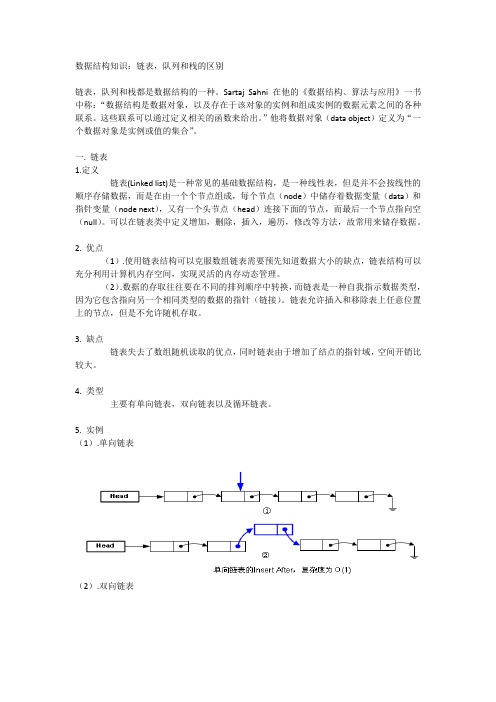
数据结构知识:链表,队列和栈的区别链表,队列和栈都是数据结构的一种。
Sartaj Sahni 在他的《数据结构、算法与应用》一书中称:“数据结构是数据对象,以及存在于该对象的实例和组成实例的数据元素之间的各种联系。
这些联系可以通过定义相关的函数来给出。
”他将数据对象(data object)定义为“一个数据对象是实例或值的集合”。
一. 链表1.定义链表(Linked list)是一种常见的基础数据结构,是一种线性表,但是并不会按线性的顺序存储数据,而是在由一个个节点组成,每个节点(node)中储存着数据变量(data)和指针变量(node next),又有一个头节点(head)连接下面的节点,而最后一个节点指向空(null)。
可以在链表类中定义增加,删除,插入,遍历,修改等方法,故常用来储存数据。
2. 优点(1).使用链表结构可以克服数组链表需要预先知道数据大小的缺点,链表结构可以充分利用计算机内存空间,实现灵活的内存动态管理。
(2).数据的存取往往要在不同的排列顺序中转换,而链表是一种自我指示数据类型,因为它包含指向另一个相同类型的数据的指针(链接)。
链表允许插入和移除表上任意位置上的节点,但是不允许随机存取。
3. 缺点链表失去了数组随机读取的优点,同时链表由于增加了结点的指针域,空间开销比较大。
4. 类型主要有单向链表,双向链表以及循环链表。
5. 实例(1).单向链表(2).双向链表6. 与数组(Array)的对比链表的使用不需要知道数据的大小,而数组在创建时必须指明数组的大小。
链表没有对应的下标,只有指向下一个数据的指针,而数组中每一个都有一个相对应的下标。
链表在内存中储存的数据可以是不连续的,而数组储存的数据占内存中连续的一段,用标识符标识。
二. 队列1. 定义队列是一种特殊的线性表,它只允许在表的前端(front)进行删除操作,而在表的后端(rear)进行插入操作。
进行插入操作的端称为队尾,进行删除操作的端称为队头。
《数据结构堆栈》PPT课件

4.2堆栈的顺序存储结构
0 1 2 ……
a1 a2 … ai
top1
top1
什么时候栈1为空?
S-1
bj … … b2 b1
top2 top1= -1
4.2堆栈的顺序存储结构
0 1 2 ……
a1 a2 … ai
top1 什么时候栈1为空? 什么时候栈2为空?
S-1
bj … … b2 b1
top2
操作接口: 入栈:p75 出栈:p75
4.3堆栈的链式存储结构
顺序栈和链栈的比较
• 时间性能:相同,都是常数时间O(1)。 • 空间性能:
– 顺序栈:有元素个数的限制和空间浪费的问题。 – 链栈:没有栈满的问题,只有当内存没有可用空间
时才会出现栈满,但是每个元素都需要一个指针域, 从而产生了结构性开销。
012 3 4 56 78
a1
top 确定用数组的哪一端表示栈底。 附设指针top指示栈顶元素在数组中的位置。
4.2堆栈的顺序存储结构
012 3 4 56 7 8
a1 a2 a3
top top top 进栈:top加1 出栈:top减1
栈空:top= -1 栈满:top= MAX_SIZE
4.2堆栈的顺序存储结构
两栈共享空间:使用一个数组来存储两个栈,让一个 栈的栈底为该数组的始端,另一个栈的栈底为该数组 的末端,两个栈从各自的端点向中间延伸。
4.2堆栈的顺序存储结构
0 1 2 ……
a1 a2 … ai
S-1
bj … … b2 b1
栈1底
top1
top2
栈2底
栈1的底固定在下标为0的一端; 栈2的底固定在下标为MaxSize-1的一端。 top1和top2分别为栈1和栈2的栈顶指针; MaxSize为整个数组空间的大小(图中用S表示);
- 1、下载文档前请自行甄别文档内容的完整性,平台不提供额外的编辑、内容补充、找答案等附加服务。
- 2、"仅部分预览"的文档,不可在线预览部分如存在完整性等问题,可反馈申请退款(可完整预览的文档不适用该条件!)。
- 3、如文档侵犯您的权益,请联系客服反馈,我们会尽快为您处理(人工客服工作时间:9:00-18:30)。
一.顺序栈1.宏定义#include<stdio.h>#include<stdlib.h>#define MAXSIZE ****#define datatype ****2.结构体typedef struct{datatype data[MAXSIZE];int top;}Seqstack;3.基本函数Seqstack *Init_Seqstack()/*置空栈函数(初始化)1.先决条件:无;2.函数作用:首先建立栈空间,然后初始化栈顶指针,返回栈s的地址*/{Seqstack *s;s=(Seqstack *)malloc(sizeof(Seqstack));s->top=-1;return s;}int Empty_Seqstack(Seqstack *s)/*判栈空函数1.先决条件:初始化顺序栈;2.函数作用:判断栈是否为空,空返回1,不空返回0*/ {if(s->top==-1) return 1;else return 0;}int Push_Seqstack(Seqstack *s,datatype x)/*入栈函数1.先决条件:初始化顺序栈2.函数作用:将数据x入栈,栈满则不能,成功返回1,因栈满失败返回0*/{if(s->top==MAXSIZE-1)return 0;s->top=s->top+1;s->data[s->top]=x;return 1;}int Pop_Seqstack(Seqstack *s,datatype *x)/*出栈函数1.先决条件:初始化顺序栈2.函数作用:从栈中出一个数据,并将其存放到x中,成功返回1,因栈空失败返回0*/{if(s->top==-1)return 0;*x=s->data[s->top];s->top--;return 1;}int Top_Seqstack(Seqstack *s,datatype *x)/*取栈顶元素函数1.先决条件:初始化顺序栈2.函数作用:取栈顶元素,并把其存放到x中,成功返回1,因栈空失败返回0*/{if(s->top==-1)return 0;*x=s->data[s->top];return 1;}int Printf_Seqstack(Seqstack *s)/*遍历顺序栈函数1.先决条件:初始化顺序栈2.函数作用:遍历顺序栈,成功返回1*/{int i,j=0;for(i=s->top;i>=0;i--){printf("%d ",s->data[i]);/*因datatype不同而不同*/j++;if(j%10==0)printf("\n");}printf("\n");return 1;}int Conversation_Seqstack(int N,int r)/*数制转换函数(顺序栈)1.先决条件:具有置空栈,入栈,出栈函数2.函数作用:将N转换为r进制的数*/{Seqstack *s;datatype x;printf("%d转为%d进制的数为:",N,r);/*以后可以删除去*/s=Init_Seqstack();do{Push_Seqstack(s,N%r);N=N/r;}while(N);while(Pop_Seqstack(s,&x)){if(x>=10)/*为了能转为十进制以上的*/printf("%c",x+55);elseprintf("%d",x);}free(s);/*释放顺序栈*/printf("\n");return 1;}4.主函数int main(){Seqstack *s;int choice;datatype x;do{printf("****************************************************************\n");printf("1.置空栈 2.判栈空 3.入栈 4.出栈 5.取栈顶元素 6.遍历7.退出\n");printf("****************************************************************\n");printf("请输入选择(1~7):");scanf("%d",&choice);getchar();switch(choice){case 1:s=Init_Seqstack();if(s)printf("置空栈成功!\n");break;case 2:if(Empty_Seqstack(s))printf("此为空栈.\n");elseprintf("此不为空栈.\n");;break;case 3:printf("请输入一个整数:");scanf("%d",&x);if(Push_Seqstack(s,x))printf("入栈成功.\n");elseprintf("栈已满,无法入栈.\n");;break;case 4:if(Pop_Seqstack(s,&x))printf("出栈成功,出栈元素为:%d\n",x);elseprintf("出栈失败,因栈为空.\n");break;case 5:if(Top_Seqstack(s,&x))printf("取栈顶元素成功,栈顶元素为:%d\n",x);elseprintf("取栈顶元素失败,因栈为空.\n");break;case 6:Printf_Seqstack(s);break;case 7:printf("谢谢使用!\n");break;default :printf("输入错误,请重新输入!\n");break;}}while(choice!=7);return 0;}二.链栈1.宏定义#include<stdio.h>#include<stdlib.h>#define datatype ****2.结构体typedef struct snode{datatype data;struct snode *next;}Stacknode,*Linkstack;3.基本函数Linkstack Init_Linkstack()/*初始化栈函数1.先决条件:无2.函数作用:初始化链栈,返回top地址*/{Linkstack top;top=(Linkstack)malloc(sizeof(Stacknode));top->next=NULL;return top;}int Empty_Linkstack(Linkstack top)/*判栈空函数1.先决条件:初始化链栈2.函数作用:判断栈是否为空,空返回1,不空返回0*/ {if(top->next==NULL)return 1;else return 0;}int Push_Linkstack(Linkstack top,datatype x)/*入栈函数1.先决条件:初始化链栈2.函数作用:将数据x入栈,成功返回1,失败返回0*/ {Stacknode *p;p=(Stacknode *)malloc(sizeof(Stacknode));p->data=x;p->next=top->next;top->next=p;return 1;}int Pop_Linkstack(Linkstack top,datatype *x)/*出栈函数1.先决条件:初始化链栈2.函数作用:若栈空退出,若没空则将数据出栈,并将其存放到x中,成功返回1,因栈空失败返回0*/{if(top->next==NULL)return 0;Stacknode *p=top->next;*x=p->data;top->next=p->next;free(p);return 1;}int Top_Linkstack(Linkstack top,datatype *x)/*取栈顶元素函数1.先决条件:初始化链栈2.函数作用:取栈顶元素并放到x中,成功返回1,因栈空失败返回0*/{if(top->next==NULL)return 0;*x=top->next->data;return 1;}int Printf_Linkstack(Linkstack top)/*遍历链栈函数1.先决条件:初始化链栈2.函数作用:遍历链栈,成功返回1*/{Stacknode *p=top->next;int j=0;while(p){printf("%d ",p->data);/*因datatype不同而不同*/j++;if(j%10==0)printf("\n");p=p->next;}printf("\n");return 1;}int Conversation_Linkstack(int N,int r)/*数制转换函数(链栈)1.先决条件:具有置空栈,入栈,出栈函数2.函数作用:将N转换为r进制的数*/{Linkstack top;datatype x;printf("%d转为%d进制的数为:",N,r);/*以后可以删除去*/top=Init_Linkstack();do{Push_Linkstack(top,N%r);N=N/r;}while(N);while(Pop_Linkstack(top,&x)){if(x>=10)/*为了能转为十进制以上的*/printf("%c",x+55);elseprintf("%d",x);}printf("\n");free(top);/*释放栈顶空间*/return 1;}4.主函数int main(){Linkstack top;int choice;datatype x;do{printf("****************************************************************\n");printf("1.置空栈 2.判栈空 3.入栈 4.出栈 5.取栈顶元素 6.遍历7.退出\n");printf("****************************************************************\n");printf("请输入选择(1~7):");scanf("%d",&choice);getchar();switch(choice){case 1:top=Init_Linkstack();if(top)printf("置空栈成功!\n");break;case 2:if(Empty_Linkstack(top))printf("此为空栈.\n");elseprintf("此不为空栈.\n");;break;case 3:printf("请输入一个整数:");scanf("%d",&x);if(Push_Linkstack(top,x))printf("入栈成功.\n");elseprintf("栈已满,无法入栈.\n");;break;case 4:if(Pop_Linkstack(top,&x))printf("出栈成功,出栈元素为:%d\n",x);elseprintf("出栈失败,因栈为空.\n");break;case 5:if(Top_Linkstack(top,&x))printf("取栈顶元素成功,栈顶元素为:%d\n",x);elseprintf("取栈顶元素失败,因栈为空.\n");break;case 6:Printf_Linkstack(top);break;case 7:printf("谢谢使用!\n");break;default :printf("输入错误,请重新输入!\n");break;}}while(choice!=7);return 0;}三.顺序队列1.宏定义#include<stdio.h>#include<stdlib.h>#define MAXSIZE ****#define datatype ****2.结构体typedef struct{datatype data[MAXSIZE];int rear,front;int num;}Sequeue;3.基本函数Sequeue *Init_Sequeue()/*初始化顺序队列函数1.先决条件:无2.函数作用:初始化顺序队列,成功返回顺序队列首地址q*/{Sequeue *q;q=(Sequeue *)malloc(sizeof(Sequeue));q->front=q->rear=MAXSIZE-1;q->num=0;return q;}int In_Sequeue(Sequeue *q,datatype x)/*入队函数1.先决条件:初始化顺序队列2.函数作用:将数据x入队到q中,成功返回1,因队满失败返回0*/{if(q->num==MAXSIZE){printf("队满.\n");/*可视情况删除此句*/return 0;}else{q->rear=(q->rear+1)%MAXSIZE;q->data[q->rear]=x;q->num++;return 1;}}int Front_Sequeue(Sequeue *q,datatype *x)/*取队头元素函数1.先决条件:初始化顺序表2.函数作用:取队头元素并将其存放到x中,成功返回1,因队空而失败返回0*/{if(q->num==0){printf("队空.\n");/*可视情况删除此句*/return 0;}*x=q->data[q->front+1];return 1;}int Out_Sequeue(Sequeue *q,datatype *x)/*出队函数1.先决条件:初始化顺序队列2.函数作用:将数据x入队到q中,成功返回1,因队空失败返回0*/{if(q->num==0){printf("队空.\n");/*可视情况删除此句*/return 0;}else{q->front=(q->front+1)%MAXSIZE;*x=q->data[q->front];q->num--;return 1;}}int Empty_Sequeue(Sequeue *q)/*判空函数1.先决条件:初始化顺序队列2.函数作用:是空返回1,非空返回0*/{if(q->num==0)return 1;else return 0;}int Printf_Sequeue(Sequeue *q)/*遍历函数1.先决条件:初始化顺序队列2.函数作用:遍历输出所有数据*/{int i,j=q->front+1,n=q->num;for(i=0;i<n;i++){printf("%d ",q->data[j]);/*因datatype数据不同而不同*/j++;j=j%MAXSIZE;}printf("\n");return 1;}4.主函数int main(){Sequeue *q;int choice;datatype x;do{printf("**************************************************************\n");printf("1.初始化 2.判队空 3.入队 4.出队 5.取队头元 6.遍历7.退出\n");printf("**************************************************************\n");printf("请输入选择(1~7):");scanf("%d",&choice);getchar();switch(choice){case 1:q=Init_Sequeue();if(q)printf("置空队成功!\n");break;case 2:if(Empty_Sequeue(q))printf("此为空队.\n");elseprintf("此不为空队.\n");;break;case 3:printf("请输入一个整数:");scanf("%d",&x);if(In_Sequeue(q,x))printf("入队成功.\n");elseprintf("队已满,无法入队.\n");;break;case 4:if(Out_Sequeue(q,&x))printf("出队成功,出队元素为:%d\n",x);elseprintf("出队失败,因队为空.\n");break;case 5:if(Front_Sequeue(q,&x))printf("取队头元素成功,队头元素为:%d\n",x);elseprintf("取队头元素失败,因队为空.\n");break;case 6:Printf_Sequeue(q);break;case 7:printf("谢谢使用!\n");break;default :printf("输入错误,请重新输入!\n");break;}}while(choice!=7);return 0;}四.链队列1.宏定义#include<stdio.h>#include<stdlib.h>#define datatype int2.结构体typedef struct node{datatype data;struct node *next;}Qnode;typedef struct{Qnode *front,*rear;}Lqueue;3.基本函数Lqueue *Init_Lqueue()/*初始化链队列函数 1.先决条件:无2.函数作用:初始化链队列,成功返回顺序队列首地址q(头结点)*/{Lqueue *q;Qnode *p;q=(Lqueue *)malloc(sizeof(Lqueue));p=(Qnode *)malloc(sizeof(Qnode));p->next=NULL;q->front=p;q->rear=p;return q;}int In_Lqueue(Lqueue *q,datatype x)/*入队函数1.先决条件:初始化链队列2.函数作用:将数据x入队到q中,成功返回1*/{Qnode *p;p=(Qnode *)malloc(sizeof(Qnode));p->data=x;p->next=NULL;q->rear->next=p;q->rear=p;return 1;}int Empty_Lqueue(Lqueue *q)/*判空函数1.先决条件:初始化链队列2.函数作用:是空返回1,非空返回0*/{if(q->front==q->rear)return 1;else return 0;}int Front_Lqueue(Lqueue *q,datatype *x)/*取队头元素函数1.先决条件:初始化链队列2.函数作用:取队头元素并将其存放到x中,成功返回1,因队空而失败返回0*/{if(Empty_Lqueue(q)){printf("队空.\n");/*可视情况删除此句*/return 0;}*x=q->front->next->data;return 1;}int Out_Lqueue(Lqueue *q,datatype *x)/*出队函数1.先决条件:初始化链队列2.函数作用:将数据x入队到q中,成功返回1,因队空失败返回0*/{Qnode *p;if(Empty_Lqueue(q)){printf("队空.\n");/*可视情况删除此句*/return 0;}p=q->front->next;*x=p->data;q->front->next=p->next;free(p);if(q->front->next==NULL)q->rear=q->front;return 1;}int Printf_Lqueue(Lqueue *q)/*遍历函数1.先决条件:初始化链队列2.函数作用:遍历输出所有数据*/{Qnode *p;for(p=q->front->next;p!=NULL;p=p->next)printf("%d ",p->data);/*因datatype数据不同而不同*/printf("\n");return 1;}4.主函数int main(){Lqueue *q;int choice;datatype x;do{printf("**************************************************************\n");printf("1.初始化 2.判队空 3.入队 4.出队 5.取队头元 6.遍历7.退出\n");printf("**************************************************************\n");printf("请输入选择(1~7):");scanf("%d",&choice);getchar();switch(choice){case 1:q=Init_Lqueue();if(q)printf("置空队成功!\n");break;case 2:if(Empty_Lqueue(q))printf("此为空队.\n");elseprintf("此不为空队.\n");;break;case 3:printf("请输入一个整数:");scanf("%d",&x);if(In_Lqueue(q,x))printf("入队成功.\n");break;case 4:if(Out_Lqueue(q,&x))printf("出队成功,出队元素为:%d\n",x);elseprintf("出队失败,因队为空.\n");break;case 5:if(Front_Lqueue(q,&x))printf("取队头元素成功,队头元素为:%d\n",x);elseprintf("取队头元素失败,因队为空.\n");break;case 6:Printf_Lqueue(q);break;case 7:printf("谢谢使用!\n");break;default :printf("输入错误,请重新输入!\n");break;}}while(choice!=7);return 0; }。
